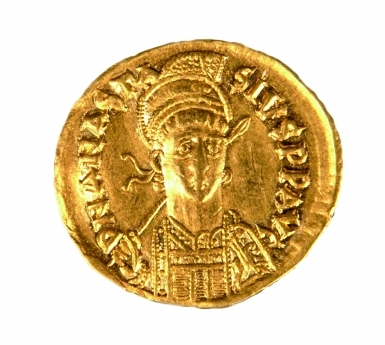 |
|
A gold Byzantine coin of the Anastasius I era.
|
A gold Byzantine coin of the Anastasius I era (491 - 518) was unearthed last October from a Northern Wei Dynasty (386-534) tomb in Luoyang, Henan province. The find caused no particular stir in China’s numismatic circles, however. Over recent decades Persian and Roman gold coins have occasionally come to light in historical sites along the ancient Silk Road.
They form part of the raft of evidence that this 2,000-year-old 7,000-km-long “road” was a vital trade route and communications network that connected China with India, Persia, Arabia, Greece and Rome.
Trade Route
German geographer Ferdinand von Richthofen was the first, in 1877, to refer to this ancient route as the Silk Road. Gemstones, silk and porcelain were most prominent among the broad range of goods transported along it from the East to the West. Exchanges of commodities and workers from the Asian and European civilizations led to an intermingling of cultures, ideas and religions, as well as of expertise in economics, politics, science and technology and military science.
Silk was the most desired Chinese export, one that Chinese envoys would most often present as gifts to foreign heads of state. This luxurious fabric was in high demand throughout the Roman Empire, a third century author having extolled its gossamer-like texture in an array of floral hues. The astronomical amounts paid for silk imports, the price for one pound of fine silk at one time soaring to 600 grams of gold, forced the senate to prohibit the wearing of silk garments. Legendary Egyptian queen Cleopatra would receive foreign diplomats attired in silk robes, and Chinese silk was found in the tomb of a pharaoh laid to rest in 1000 BC. Phoenician red silk robes came into vogue among royal families and the aristocracy of Eastern and Western Europe. Even the Koran praises Chinese silk as a heavenly fabric.
We Recommend:
